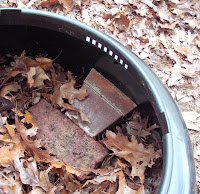We didn’t keep the secret to ourselves. Betty tried to get our town into the business
of selling discounted composters to residents.
The town lacked the infrastructure but a state program encouraging their
sale didn’t specify that towns must be involved, just non-profit organizations.
And so, every spring for the next seven years, we sold
composters out of our driveway under the banner of our town’s garden club. Over the course of that time, we ‘placed’
more than 700 composters in a town with about 11,000 residents. It is quite possible that Medfield has the
highest concentration of composter ownership in Massachusetts.
 |
| A squirrel gnawed a hole in our new composter... |
I offer this background because, until about a month ago,
composting was for us basically as painless as it was morally uplifting. Then, one morning, I noticed that a hole had
been gnawed through the air grates in our Earth Machine composter. Something – probably a squirrel – had set
about gaining entry and we were left with a trail of debris leading out of the cavity. The solution was a new composter. The old one was, I imagined, getting elderly
and brittle. The new one was installed
and the contents transferred.
 |
| ...so I attempted a fix... |
That should have been the end of the story. Unfortunately, it wasn’t. A week before Thanksgiving, I went out one
morning and found a hole gnawed through one of the air vents. When I opened the composter lid, a gray blur
streaked out of it. We had squirrels.
I figured out a quick and easy fix: a metal pot to cover the hole and a brick to
hold the pot in place. To the mechanical
solution was added a chemical one: a daily spritz of, ummm, an organic,
uric-acid-based liquid. That would be the
end of the never-ending Sunday brunch at the Sanders home. For a week, things were swell. The pot stayed in place and the spritz dampened
interest on the part of other, would-be intruders.
 |
| ...which led to a coordinated, nighttime assault. |
Then, three days after Thanksgiving I found we had been the
victims of a daring, coordinated nighttime raid. Not only had the pot been pushed out of the
way, but two new holes had been gnawed through the plastic air vents. The ground around the composter was littered
with the remnants of meals past. Nearby,
I thought I heard the sound of belching as squirrels digested the contents of
our composter.
As I stared at the three holes, all I could think of was a
sputtering Daffy Duck saying to his nemesis, “Of course you know, this means
war.” I was not going to be defeated by
a gang of marauding squirrels.
 |
| The wire mesh includes lots of nasty spikes to deter inquiring paws. |
I found what I hope is the solution at my local hardware
store. When you go to a big-box store,
all solutions are nuclear. At Will’s
Hardware, the questions were gentle but probing; the solution inspired Instead of squirrel traps or poison, I walked
out with an eight-dollar, five-foot length of hardware cloth, which I placed
inside the perimeter of the composter. Nasty
spikes of wire affixed the wire mesh to the remnants of the plastic grates, the
better to impale inquiring paws.
I don’t know if the solution is permanent. I hope it is.
We’ve put a lot of composters in a lot of yards in town, and our
reputation is on the line.



